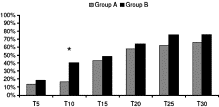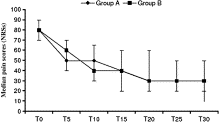Is there an ideal morphine dose for prehospital treatment of severe acute pain? A randomized, double-blind comparison of 2 doses☆☆☆★★
To view the full text, please login as a subscribed user or purchase a subscription. Click here to view the full text on ScienceDirect.

Fig. 1
Patient enrollment and group allocation.

Fig. 2
Percentage of patients with an NRS score of 30/100 or lower in groups A and B. P values are nonsignificant except for the asterisk indicating P < .01 at 10 minutes after the injection.

Fig. 3
Evolution of NRS scores in groups A and B. All values are plotted as median ± interquartile range.
Abstract
Study objective
We aimed to determine the best intravenous morphine titration protocol by comparing 2 protocols for prehospital treatment of patients with severe acute pain.
Methods
Eligible patients with a numerical rating scale (NRS) score of 60/100 or higher were randomlyallocated to receive either 0.05 mg/kg morphine then 0.025 mg/kg every 5 minutes (group A) or 0.1 mg/kg morphine then 0.05 mg/kg every 5 minutes (group B) intravenously. The protocol-defined primary outcome measure was the percentage of patients with pain relief (with a NRS score of 30/100 or lower) 30 minutes after the first injection.
Results
A total of 106 consecutive patients were randomized. Thirty minutes after the injection, 66% of the patients in group A had an NRS of 30 or lower vs 76% of those in group B (P = .25). Ten minutes after the injection, 17% of the patients in group A had an NRS score of 30 or lower vs 40% of those in group B, (odds ratio, 3.4; 95% confidence interval, 1.3-8.8; P < .01). Patients in group B were significantly more satisfied with their analgesia. In addition, there were no serious complications in either group. However, patients in group B did experience almost twice the incidence of adverse effects overall and in particular 4times the level of emesis, although neither of these observations were statistically significant. Using univariate and multivariate analysis, only an initial NRS score of 100 was an independent predictive factor for failure of analgesia (odds ratio, 0.125; 95% confidence interval, 0.02-0.68; P < .05).
Conclusion
The high-dose morphine regimen showed a similar analgesic response pattern to the low-dose one in severe acute pain in a prehospital setting. Patients in the high-dose group were more likely to experience pain relief 10 minutes after the injection. In the interests of achieving rapid pain relief, an initial dose of 0.05 mg/kg should no longer be recommended for treating severe acute pain in a prehospital setting. Another important message arising from our study is that a regimented dose of morphine, with an initial dose and strictly administered lower doses at regular intervals, is safe in the prehospital setting.
To access this article, please choose from the options below
Purchase access to this article
Claim Access
If you are a current subscriber with Society Membership or an Account Number, claim your access now.
Subscribe to this title
Purchase a subscription to gain access to this and all other articles in this journal.
Institutional Access
Visit ScienceDirect to see if you have access via your institution.
☆Support was provided solely by institutional sources; this work was sponsored by the University Hospital of Toulouse for regulatory and ethic submission.
☆☆This study has the ClinicalTrials.gov registration number NCT00237731.
★★Work is attributed to Service d'Aide Médicale Urgente 31, Center Hospitalier Universitaire Purpan, Toulouse, France.
Related Articles
Searching for related articles..



